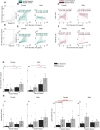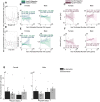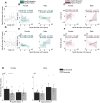The impact of apolipoprotein E, type ∊4 allele on Alzheimer's disease pathological biomarkers: a comprehensive post-mortem pilot-analysis
- PMID: 39913635
- PMCID: PMC11801730
- DOI: 10.1371/journal.pone.0303486
The impact of apolipoprotein E, type ∊4 allele on Alzheimer's disease pathological biomarkers: a comprehensive post-mortem pilot-analysis
Abstract
The apolipoprotein E type ∊4 allele (ApoE4) is known as the strongest genetic risk factor for Alzheimer's Disease (AD). Meanwhile, many aspects of its impact on AD pathology remain underexplored. This study conducts a systematic data analysisof donor data from the Seattle Alzheimer's Disease Brain Cell Atlas. Our investigation delves into the intricate interplay between identified biomarkers and their correlation with ApoE4 across all severities of AD. Employing Pearson R correlation, and one-way and two-way ANOVA tests, we elucidate the pathological changes in biomarkers and the altering effects of ApoE4. Remarkably, the phosphorylation of tau observed in neurofibrillary tangles (NFTs) marked by the AT8 antibody, emerges as the most correlated factor with other pathological biomarkers. This correlation is mediated by both tau and amyloid pathology, suggesting a higher hierarchical role in determining AD pathological effects than other biomarkers. However, non-ApoE4 carriers exhibit a more significant correlation with disease progression severity compared to ApoE4 carriers, though ApoE4 carriers demonstrate significance in exacerbating the effect of accumulating phosphorylated tau and amyloid plaques assessed by AT8 and 6E10 antibodies. Furthermore, our analysis does not observe dramatic neuronal changes in grey matter across the span of AD pathology. Glia activation, measured by Iba1 and GFAP, demonstrates an amyloid-specific correlation. This research marks the first human post-mortem analysis providing a comprehensive examination of prevailing AD biomarkers and their interconnectedness with pathology and ApoE4 genetic factor. Limitations in the study are acknowledged, underscoring the need for further exploration and refinement in future research endeavors.
Copyright: This is an open access article, free of all copyright, and may be freely reproduced, distributed, transmitted, modified, built upon, or otherwise used by anyone for any lawful purpose. The work is made available under the Creative Commons CC0 public domain dedication.
Conflict of interest statement
The authors have declared that no competing interests exist.
Figures








Similar articles
-
Co-Expression of Glia Maturation Factor and Apolipoprotein E4 in Alzheimer's Disease Brain.J Alzheimers Dis. 2018;61(2):553-560. doi: 10.3233/JAD-170777. J Alzheimers Dis. 2018. PMID: 29172001 Free PMC article.
-
Dissecting phenotypic traits linked to human resilience to Alzheimer's pathology.Brain. 2013 Aug;136(Pt 8):2510-26. doi: 10.1093/brain/awt171. Epub 2013 Jul 3. Brain. 2013. PMID: 23824488 Free PMC article.
-
Soluble pre-fibrillar tau and β-amyloid species emerge in early human Alzheimer's disease and track disease progression and cognitive decline.Acta Neuropathol. 2016 Dec;132(6):875-895. doi: 10.1007/s00401-016-1632-3. Epub 2016 Oct 21. Acta Neuropathol. 2016. PMID: 27770234 Free PMC article.
-
Neuroimaging biomarkers for Alzheimer's disease in asymptomatic APOE4 carriers.Rev Neurol (Paris). 2013 Oct;169(10):729-36. doi: 10.1016/j.neurol.2013.07.025. Epub 2013 Sep 6. Rev Neurol (Paris). 2013. PMID: 24016463 Review.
-
Invited Review: APOE at the interface of inflammation, neurodegeneration and pathological protein spread in Alzheimer's disease.Neuropathol Appl Neurobiol. 2019 Jun;45(4):327-346. doi: 10.1111/nan.12529. Epub 2018 Nov 28. Neuropathol Appl Neurobiol. 2019. PMID: 30394574 Free PMC article. Review.
Cited by
-
Genomic Characterisation of the Relationship and Causal Links Between Vascular Calcification, Alzheimer's Disease, and Cognitive Traits.Biomedicines. 2025 Mar 3;13(3):618. doi: 10.3390/biomedicines13030618. Biomedicines. 2025. PMID: 40149595 Free PMC article.
References
-
- Farrer L, Cupples L, Haines J, Hyman B, Kukull W, Mayeux R, et al.. Effects of age, sex, and ethnicity on the association between apolipoprotein E genotype and Alzheimer disease: a meta-analysis. JAMA. 1997. Oct 22;278(16):1349–56. - PubMed
-
- Kockx M, Traini M, Kritharides L. Cell-specific production, secretion, and function of apolipoprotein E. J Mol Med. 2018. May 1;96(5):361–71. - PubMed
MeSH terms
Substances
Grants and funding
LinkOut - more resources
Full Text Sources
Medical
Miscellaneous

